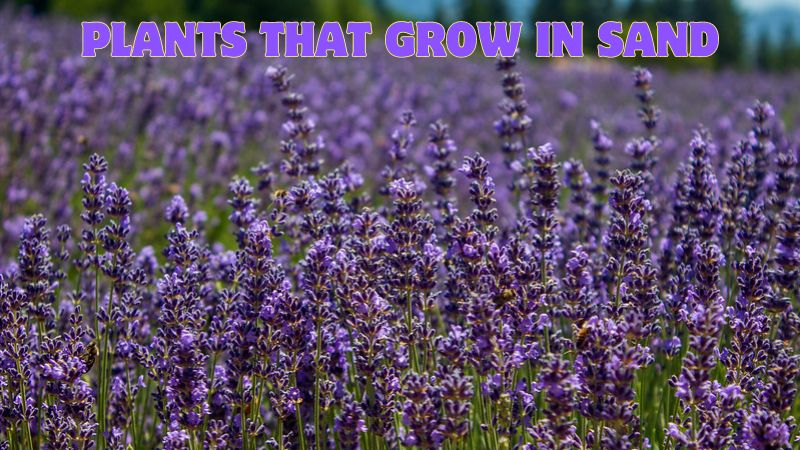Growing plants in sandy soil can present a unique set of challenges and opportunities. Sandy soil is well-draining and can quickly become nutrient-poor, but it is also easy to work with and warms up faster in the spring. Below, Tropical Fish Haven will introduce to you a list of the 10 best plants that grow in sand, bringing beauty and utility to your garden despite the less than ideal soil.
Plants That Grow In Sand
Lavender (Lavandula)
Lavender is a fragrant herb that thrives in sandy soil. Its Mediterranean origins mean it prefers well-drained soils and full sunlight. Lavender is not only a beautiful addition to any garden with its purple flowers, but it also attracts pollinators like bees and butterflies. It’s relatively low-maintenance, requiring minimal watering once established, and can even tolerate drought conditions.
Sedum (Sedum spp.)
Sedum, also known as stonecrop, is a succulent that thrives in sandy, well-drained soils. These plants are incredibly drought-tolerant and come in a variety of shapes, sizes, and colors. Sedums are ideal for rock gardens, borders, and ground cover. They produce star-shaped flowers that attract pollinators and add a splash of color to the garden.
Blanket Flower (Gaillardia)
Blanket flowers are hardy perennials that thrive in sandy soil and full sun. Known for their vibrant red, yellow, and orange blooms, these flowers can brighten up any garden. Blanket flowers are also great for attracting butterflies and other pollinators.
Yarrow (Achillea millefolium)
Yarrow is a tough perennial that grows well in sandy soil. It produces clusters of small, flat-topped flowers that can be white, yellow, pink, or red. It also has medicinal properties and is often used in traditional herbal remedies.
Russian Sage (Perovskia atriplicifolia)
Russian Sage is a hardy perennial that thrives in sandy soil and full sun. It produces tall spikes of lavender-blue flowers and silvery foliage, adding a touch of elegance to the garden. Russian Sage is drought-tolerant and requires minimal maintenance. It’s also deer-resistant, making it a good choice for areas with wildlife.
Sea Holly (Eryngium)
Sea Holly is an unusual and striking plant that thrives in sandy, well-drained soil. It produces spiky, metallic-blue flowers that add a unique texture to the garden. Sea Holly is drought-tolerant and requires little maintenance once established. It’s also a favorite among pollinators, especially bees.
Daylily (Hemerocallis)
Daylilies are hardy perennials that can grow in almost any soil type, including sandy soil. They produce trumpet-shaped flowers in a wide range of colors, from yellow and orange to pink and red. Daylilies are very low-maintenance and drought-tolerant, making them an excellent choice for sandy gardens.
Butterfly Weed (Asclepias tuberosa)
Butterfly Weed is a native perennial that thrives in sandy soil and full sun. It produces bright orange flowers that attract butterflies, especially monarchs. Butterfly Weed is drought-tolerant and requires minimal care once established. It’s an excellent choice for adding color and attracting wildlife to sandy gardens.
Cacti and Succulents
Cacti and succulents are well-known for their ability to thrive in sandy, well-drained soils. These plants are incredibly drought-tolerant and come in a variety of shapes and sizes. They require minimal water and care, making them perfect for sandy gardens. Some popular choices include Echeveria, Aloe, and Agave.
Rosemary (Rosmarinus officinalis)
Rosemary is a fragrant herb that thrives in sandy soil and full sun. It produces needle-like leaves and small blue flowers. Rosemary is drought-tolerant and requires little maintenance once established. It’s not only a beautiful addition to the garden but also a useful culinary herb.
Tips for Growing Plants in Sandy Soil
Improve Soil Quality: While many plants can tolerate sandy soil, adding organic matter like compost or well-rotted manure can improve soil fertility and water retention.
Mulching: Mulching helps retain moisture and suppress weeds. Use organic mulch like straw, bark, or compost around your plants.
Watering: Sandy soil drains quickly, so regular watering may be necessary, especially during dry periods. However, it’s important to avoid overwatering, which can lead to root rot.
Conclusion
Sandy soil may pose some challenges for gardeners, but with the right plants and proper care, you can create a thriving garden. The plants listed above are well-suited to sandy conditions and can bring beauty, color, and life to your garden. By improving soil quality and following good gardening practices, you can enjoy a diverse and vibrant landscape, even in sandy areas





